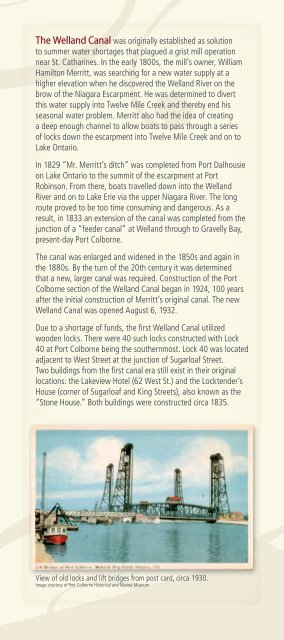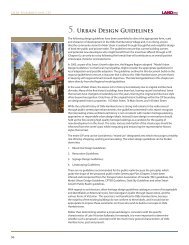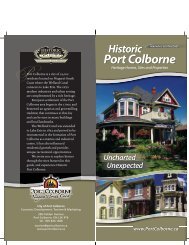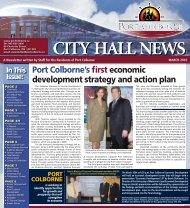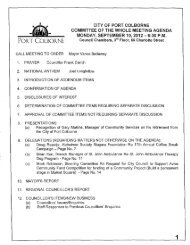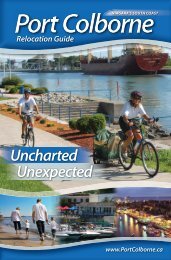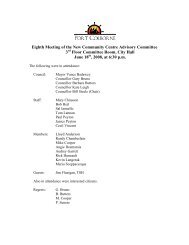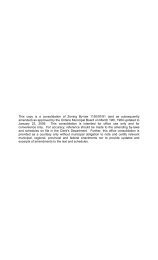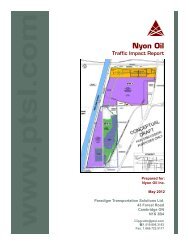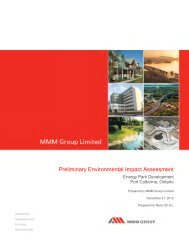Welland Canal - City of Port Colborne
Welland Canal - City of Port Colborne
Welland Canal - City of Port Colborne
Create successful ePaper yourself
Turn your PDF publications into a flip-book with our unique Google optimized e-Paper software.
The <strong>Welland</strong> <strong>Canal</strong> was originally established as solution<br />
to summer water shortages that plagued a grist mill operation<br />
near St. Catharines. In the early 1800s, the mill’s owner, William<br />
Hamilton Merritt, was searching for a new water supply at a<br />
higher elevation when he discovered the <strong>Welland</strong> River on the<br />
brow <strong>of</strong> the Niagara Escarpment. He was determined to divert<br />
this water supply into Twelve Mile Creek and thereby end his<br />
seasonal water problem. Merritt also had the idea <strong>of</strong> creating<br />
a deep enough channel to allow boats to pass through a series<br />
<strong>of</strong> locks down the escarpment into Twelve Mile Creek and on to<br />
Lake Ontario.<br />
In 1829 “Mr. Merritt’s ditch” was completed from <strong>Port</strong> Dalhousie<br />
on Lake Ontario to the summit <strong>of</strong> the escarpment at <strong>Port</strong><br />
Robinson. From there, boats travelled down into the <strong>Welland</strong><br />
River and on to Lake Erie via the upper Niagara River. The long<br />
route proved to be too time consuming and dangerous. As a<br />
result, in 1833 an extension <strong>of</strong> the canal was completed from the<br />
junction <strong>of</strong> a “feeder canal” at <strong>Welland</strong> through to Gravelly Bay,<br />
present-day <strong>Port</strong> <strong>Colborne</strong>.<br />
The canal was enlarged and widened in the 1850s and again in<br />
the 1880s. By the turn <strong>of</strong> the 20th century it was determined<br />
that a new, larger canal was required. Construction <strong>of</strong> the <strong>Port</strong><br />
<strong>Colborne</strong> section <strong>of</strong> the <strong>Welland</strong> <strong>Canal</strong> began in 1924, 100 years<br />
after the initial construction <strong>of</strong> Merritt’s original canal. The new<br />
<strong>Welland</strong> <strong>Canal</strong> was opened August 6, 1932.<br />
Due to a shortage <strong>of</strong> funds, the first <strong>Welland</strong> <strong>Canal</strong> utilized<br />
wooden locks. There were 40 such locks constructed with Lock<br />
40 at <strong>Port</strong> <strong>Colborne</strong> being the southernmost. Lock 40 was located<br />
adjacent to West Street at the junction <strong>of</strong> Sugarloaf Street.<br />
Two buildings from the first canal era still exist in their original<br />
locations: the Lakeview Hotel (62 West St.) and the Locktender’s<br />
House (corner <strong>of</strong> Sugarloaf and King Streets), also known as the<br />
“Stone House.” Both buildings were constructed circa 1835.<br />
Lighthouses & Breakwater<br />
The first lighthouse in <strong>Port</strong> <strong>Colborne</strong> was built in the 1830s, shortly<br />
after the <strong>Welland</strong> <strong>Canal</strong> was extended to Lake Erie. Since then, the<br />
entrance to the canal has been reconfigured several times, which<br />
has made it necessary for new lighthouses to be built to continue<br />
<strong>Port</strong> <strong>Colborne</strong> inner range lighthouse, built in 1903.<br />
providing a navigational beacon for ships entering the canal.<br />
At present, <strong>Port</strong> <strong>Colborne</strong> has two lighthouses on the western<br />
breakwater in Gravelly Bay. The inner range light was built in 1903<br />
consisting <strong>of</strong> a three-storey white concrete tower topped with a red<br />
parapet and lantern room. A large utility building is attached to it.<br />
The outer range light was built in 1928 when an older range light<br />
further inland was torn down. The new lighthouse is a one-anda-half<br />
storey white concrete structure that is square in shape. It is<br />
topped with a red parapet and lantern room and also houses <strong>Port</strong><br />
<strong>Colborne</strong>’s fog horn. On the eastern side <strong>of</strong> the canal entrance, ships<br />
are guided by beacons atop two modern, concrete towers.<br />
The Gravelly Bay break water protects Gravelly Bay and the entrance<br />
<strong>of</strong> the canal from rough water when there are storms over Lake<br />
Erie. It also protects from icedams in the winter. The wall is over 1.3<br />
kilometres in length and is ‘Y’ shaped. It was originally constructed<br />
in 1873, with extensions added in 1931.<br />
View <strong>of</strong> old locks and lift bridges from post card, circa 1930.<br />
Image courtesy <strong>of</strong> <strong>Port</strong> <strong>Colborne</strong> Historical and Marine Museum<br />
<strong>Port</strong> <strong>Colborne</strong> outer range lighthouse, built in 1928.


